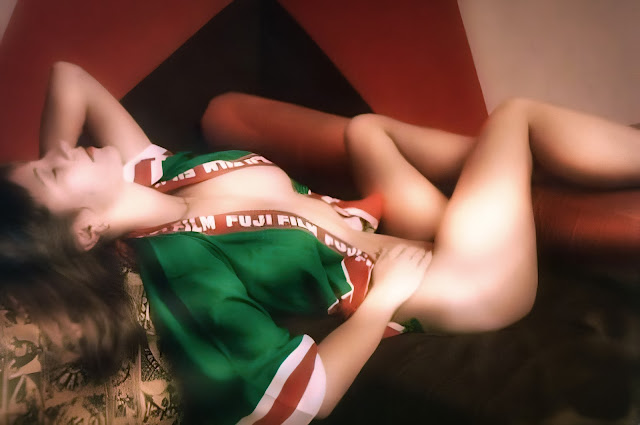...and this friend, knowing I was pretty good at photo editing, asked if I could do a favor for him. See, this friend is roughly the same age as I am, and like me is into photography (but not quite as seriously as I) and way back (let's say in the mid-to-late 1970s) he took a lot of photos of the, um, boudoir genre.
When I saw what I was going to be working with, I wondered what I what I'd gotten into. The original prints looked like they had been in ̶m̶y̶ his drawer for the last 45 years. And they were tiny! 3.5 x 5, silk surface paper, with round corners! Remember those?
And check out those colors! Jaundice city! This was not going to be the easiest project I ever took on. But... I had a secret weapon! Oh yeah, Luminar Neo had all the tools I needed to fix the colors, remove the annoying silk texture, and make a much larger image file using UpscaleAI.. from 40KB to 3MB with the click of a button. I had not done this kind of work, ever, and yet Luminar Neo is so intuitive (and quick) that it was easy to figure out what tools would do what. And of course, if I didn't like a result, it's simple to back out, with no effect on my original image file because as I may or may not have harped on many times, Luminar Neo (in fact all the previous versions of Luminar as well) is a totally non-destructive process. No matter how many changes you make to an image, your original file is untouched. Cool huh?
And then, there was Studio Lighting. I had, in my possession the beta version of the upcoming feature, Studio Lighting, which will show up in the Portrait Tools on the next update around the end of this month. It allows you to re-create many dramatic lighting lighting effects heretofore only available using actual, you know, studio lighting. I actually found this fairly daunting, because there were so many controls and I just had to fiddle around with each one to see what they would do (remember "non-destructive process?" Good thing).
In the end I ended up with a simple "stripe" lighting effect, (think sunlight through vertical blinds). Just the right "punch". Added a simple vignette, and called it "done". I'm pretty happy with the result. Pretty sure you'll agree, the final image is a far cry from where I started. This is easily the most accurate color I've gotten from faded and color-shifted old prints or slides. Now that I know what's required, I might work on more of ̶m̶y̶ his old photos!
Now, after the image, I'll fill you in on all the exciting new updates and extensions coming this autumn from Skylum and Luminar Neo....
 |
| Famous Fujifilm Kimono ©Daniel Gauss/Shot On Site |
As I mentioned above, Studio Light will be available on August 31, but you can get early bird pricing for all Luminar Neo platforms starting now through August 27th. Here's the deets:
New purchasers have a choice of:
- the brand new Pro Monthly subscription, $14/mo
- Pro 12 Month subscription, $99 instead of $119
- Pro 24 Month subscription, $139 instead of $179 👈 (Best deal, of course)
- New Lifetime purchasers (if you'd rather pick and choose your Extensions) $249 instead of $279 (Trust me, the subscription model is the way to go)
If you're an existing Lifetime user, you might want the 2023/2024 Creative Journey Pass for $39 instead of $79. You will need this to get the next update with Studio Lighting.
There's so much more to come this Fall, and I'll tell you all about it the very next post! But for now, to take advantage of the early bird prices click on this. And remember, to use the code: AFS-rdFDRy at checkout to save an additional 10%! (PHOTODAN may work as well and you won't have to cut and past, or try to remember that first one)
Here's more samples (by other folks) of Studio Lighting tool...
Posts may contain affiliate links. If you make a purchase through one of these, I may receive a small commission at no increased cost to you. Thanks.



